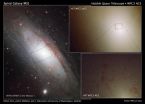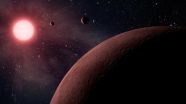(Press-News.org) Tropical Storm Heidi is forecast to make landfall today along the Pilbara coast of Western Australia as warnings pepper the coast. NASA's Aqua satellite passed overhead early in the day and captured a visible image showing Heidi's center still north of the Pilbara coast, while her outer bands continue to bring rainfall and gusty winds to coastal residents.
NASA's Aqua satellite passed over Heidi on January 11, 2012 at 02:30 UTC (Jan. 10 at 10:30 a.m. EST) and the Moderate Resolution Imaging Spectroradiometer captured a visible image of the storm. The image showed that Heidi maintained her well-rounded shape and her center was just north of the Pilbara Coast of Western Australia at that time.
There are several warnings in effect in Australia as Heidi approaches. According to the Australian Bureau of Meteorology (ABM), a Cyclone Warning is active for "coastal areas from Wallal to Dampier, including Port Hedland, Roebourne, Karratha and Dampier, and extends to adjacent inland parts." In addition, a Red Alert is up for the "coastal and island communities between Pardoo and Whim Creek, including the communities of Pardoo, Port Hedland, South Hedland, and Whim Creek." A Blue Alert is in effect for the "coastal and island communities between Whim Creek and Dampier, including the communities of Roebourne, Pt Samson, Karratha, and Dampier."
At 1500 UTC (10 a.m. EST) Heidi's maximum sustained winds have increased to 55 knots (63 mph/101 kmh. Heidi's center was still off-shore at about 45 nautical miles (52 miles/83 km) north-northeast of Port Hedland, Australia near 19.6 South and 118.9 East. Heidi was moving slowly at 4 knots (5 mph/7 kph) to the south-southwest.
NASA's Atmospheric Infrared Sounder (AIRS) instrument captured an image of Heidi at the same time as the MODIS instrument because they fly aboard the same satellite. The infrared data showed that Heidi was becoming more tightly wound. Forecasters using the AIRS data at the Joint Typhoon Warning Center noted that there is "convection gathering more directly over the top of the system."
Heidi is expected to strengthen a little more before making landfall because it's in an area of low vertical wind shear (winds that can weaken a storm or tear it apart) and sea surface temperatures warmer than needed to maintain a tropical cyclone. The sea surface temperatures off the Pilbara coast are near 30 degrees Celsius (86 F) and only 26.6C (80F) is needed to sustain a tropical cyclone. Anything warmer adds power to the cyclone through evaporation.
The ABM's forecast track for Heidi can be seen on their website at: http://www.bom.gov.au/products/IDW60281.shtml.
Heidi is expected intensify until it makes landfall. Landfall is expected today between Port Hedland and Point Samson. Heidi is expected to weaken after landfall as it heads to the south-southwest over the next couple of days.
INFORMATION:
Images: http://www.nasa.gov/mission_pages/hurricanes/archives/2012/h2012_heidi.html
NASA sees Tropical Storm Heidi approaching Australia's Pilbara coast
2012-01-13
ELSE PRESS RELEASES FROM THIS DATE:
Rare ultra-blue stars found in neighboring galaxy's hub
2012-01-13
Peering deep inside the hub of the neighboring Andromeda galaxy, NASA's Hubble Space Telescope has uncovered a large, rare population of hot, bright stars.
Blue is typically an indicator of hot, young stars. In this case, however, the stellar oddities are aging, sun-like stars that have prematurely cast off their outer layers of material, exposing their extremely blue-hot cores.
Astronomers were surprised when they spotted these stars because physical models show that only an unusual type of old star can be as hot and as bright in ultraviolet light.
While Hubble has ...
Hubble zooms in on double nucleus in Andromeda galaxy
2012-01-13
A new Hubble Space Telescope image centers on the 100-million-solar-mass black hole at the hub of the neighboring spiral galaxy M31, or the Andromeda galaxy, the only galaxy outside the Milky Way visible to the naked eye and the only other giant galaxy in the local group.
This is the sharpest visible-light image ever made of the nucleus of an external galaxy.
The event horizon, the closest region around the black hole where light can still escape, is too small to be seen, but it lies near the middle of a compact cluster of blue stars at the center of the image. The ...
People mimic each other, but we aren't chameleons
2012-01-13
It's easy to pick up on the movements that other people make—scratching your head, crossing your legs. But a new study published in Psychological Science, a journal of the Association for Psychological Science, finds that people only feel the urge to mimic each other when they have the same goal.
It's common for people to pick up on each other's movements. "This is the notion that when you're having a conversation with somebody and you don't care where your hands are, and the other person scratches their head, you scratch your head," says Sasha Ondobaka of the Donders ...
A diet rich in slowly digested carbs reduces markers of inflammation in overweight and obese adults
2012-01-13
SEATTLE – Among overweight and obese adults, a diet rich in slowly digested carbohydrates, such as whole grains, legumes and other high-fiber foods, significantly reduces markers of inflammation associated with chronic disease, according to a new study by Fred Hutchinson Cancer Research Center. Such a "low-glycemic-load" diet, which does not cause blood-glucose levels to spike, also increases a hormone that helps regulate the metabolism of fat and sugar. These findings are published online ahead of the February print issue of the Journal of Nutrition.
The controlled, ...
Astronomers find 3 smallest planets outside solar system
2012-01-13
PASADENA, Calif. -- A team of astronomers led by scientists at the California Institute of Technology (Caltech) has discovered the three smallest confirmed planets ever detected outside our solar system. The three planets, which all orbit a single star, are smaller than Earth and appear to be rocky with a solid surface. Until now, astronomers have found at most only four other rocky planets, also called terrestrial planets, around other stars.
The trio of new planets is too close to the central star to be in its habitable zone—the ring-shaped region around a star where ...
Hubble solves mystery on source of supernova in nearby galaxy
2012-01-13
Using NASA's Hubble Space Telescope, astronomers have solved a longstanding mystery on the type of star, or so-called progenitor, which caused a supernova seen in a nearby galaxy. The finding yields new observational data for pinpointing one of several scenarios that trigger such outbursts.
Based on previous observations from ground-based telescopes, astronomers knew the supernova class, called a Type Ia, created a remnant named SNR 0509-67.5, which lies 170,000 light-years away in the Large Magellanic Cloud galaxy.
Theoretically, this kind of supernova explosion is ...
New information on the waste-disposal units of living cells
2012-01-13
Important new information on one of the most critical protein machines in living cells has been reported by a team of researchers with the U.S. Department of Energy's Lawrence Berkeley National Laboratory (Berkeley Lab) and the University of California (UC) Berkeley. The researchers have provided the most detailed look ever at the "regulatory particle" used by the protein machines known as proteasomes to identify and degrade proteins that have been marked for destruction. The activities controlled by this regulatory particle are critical to the quality control of cellular ...
A clue to the GI problems that plague many kids with autism?
2012-01-13
January 11, 2012 -- New research conducted in the Center for Infection and Immunity (CII) at Columbia University's Mailman School of Public Health, reports that children with autism and gastrointestinal disturbances have high levels of a bacterium called Sutterella in their intestines.
Study findings are published online in the journal mBio.
The investigators found that over half of the children diagnosed with autism and gastrointestinal disturbances had Sutterella in intestinal biopsy tissue, while Sutterella was absent in biopsies from typically developing children ...
Treatment with light benefits Alzheimer's patients, Wayne State University finds
2012-01-13
Detroit - Exposure to light appears to have therapeutic effects on Alzheimer's disease patients, a Wayne State University researcher has found.
In a study published recently in the Western Journal of Nursing Research, LuAnn Nowak Etcher, Ph.D., assistant professor of nursing, reported that patients treated with blue-green light were perceived by their caregivers as having improved global functioning.
Caregivers said patients receiving the treatment seemed more awake and alert, were more verbally competent and showed improved recognition, recollection and motor coordination. ...
Rice's 'quantum critical' theory gets experimental boost
2012-01-13
New evidence this week supports a theory developed five years ago at Rice University to explain the electrical properties of several classes of materials -- including unconventional superconductors -- that have long vexed physicists.
The findings in this week's issue of Nature Materials uphold a theory first offered in 2006 by physicist Qimiao Si, Rice's Harry C. and Olga K. Wiess Professor of Physics and Astronomy. They represent an important step toward the ultimate goal of creating a unified theoretical description of the quantum behavior of high-temperature superconductors ...





